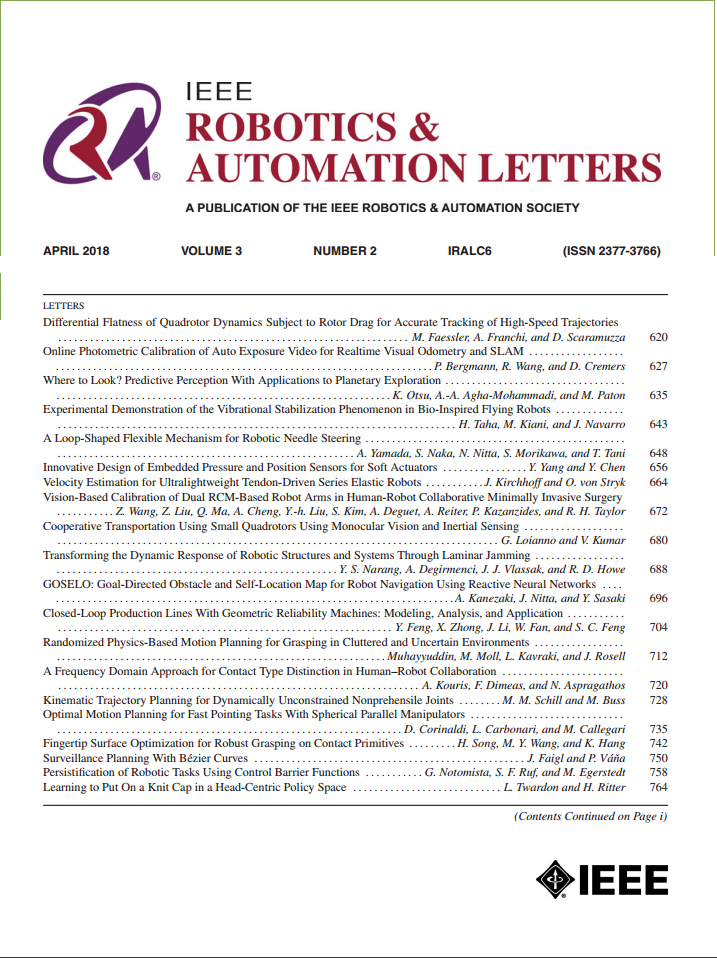集成强化学习和虚拟夹具的更安全自动机器人手术
IF 4.6
2区 计算机科学
Q2 ROBOTICS
引用次数: 0
摘要
机器人自动化的一个主要问题是安全,特别是在手术场景中。在这封信中,我们提出了一个基于虚拟夹具(VF)的安全强化学习框架来确保安全约束。该框架保证了智能体,特别是多关节机械臂智能体在硬约束条件下的行为。在训练阶段,VF将智能体的探索限制在一个安全的操作空间内。其核心思想是,一旦agent违反了VF,它将被推回安全区域。然后,收集VF修正后的安全动作,形成安全经验,用于后续的策略优化,我们称之为安全经验重塑(SER)。随后,我们设计了一个视觉模块来检测安全约束,以构建VF并将训练好的策略传递给真实的机器人。我们将我们的框架与5种最先进的强化学习方法和一种非基于学习的方法进行了比较。结果表明,该框架具有较低的约束违反率和较好的任务成功率。此外,除了静态约束任务外,我们还设计了两个涉及动态约束的任务,突出了我们的方法在处理动态约束方面的优势。我们物理实验的视频可以在以下链接中找到(淋巴结切除,人机协作1,人机协作2)。本文章由计算机程序翻译,如有差异,请以英文原文为准。
Integrating Reinforcement Learning and Virtual Fixtures for Safer Automatic Robotic Surgery
A primary concern in robotic automation is safety, especially in surgical scenarios. In this letter, we propose a virtual fixture (VF) based safe reinforcement learning framework to ensure safety constraints. The framework ensures that the agent, particularly multi-joint robotic manipulator agents, acts within the hard constraints. In the training phase, VF confines the exploration of the agent within a safe operational space. The core idea is that once the agent violates the VF, it will be pushed back to the safe region. Then, the safe action corrected by the VF is collected and forms a safe experience used for subsequent policy optimization, which we refer to as safety experience reshaping (SER). Subsequently, we design a visual module to detect safety constraints to construct the VF and transfer the trained policy to the real robot. We compare our framework to 5 state-of-the-art RL methods and a nonlearning-based method. Results show that our framework gets a lower rate of constraint violations and better performance in task success. Furthermore, in addition to the static constraint tasks, we also designed two tasks involving dynamic constraints, highlighting the superiority of our method in handling dynamic constraints. The videos of our physical experiment can be found in the following links (Lymph node removal, Human-robot collaboration 1, Human-robot collaboration 2).
求助全文
通过发布文献求助,成功后即可免费获取论文全文。
去求助
来源期刊

IEEE Robotics and Automation Letters
Computer Science-Computer Science Applications
CiteScore
9.60
自引率
15.40%
发文量
1428
期刊介绍:
The scope of this journal is to publish peer-reviewed articles that provide a timely and concise account of innovative research ideas and application results, reporting significant theoretical findings and application case studies in areas of robotics and automation.
 求助内容:
求助内容: 应助结果提醒方式:
应助结果提醒方式:


